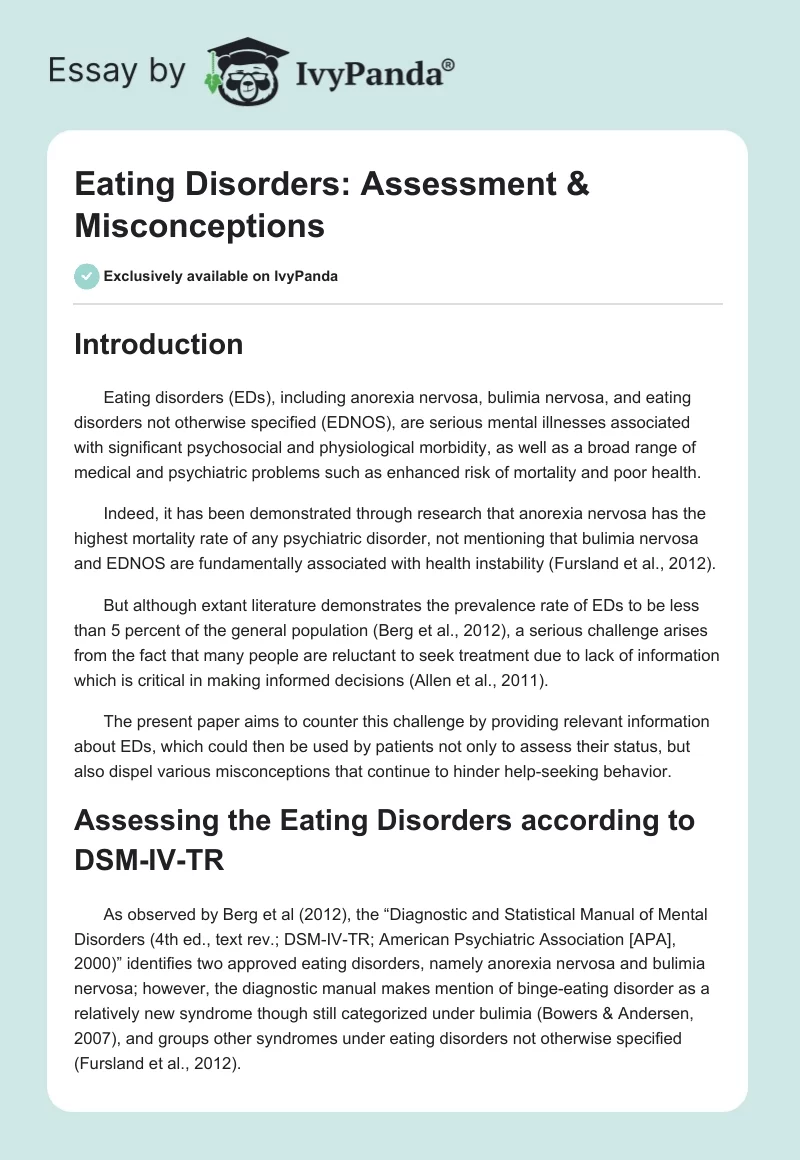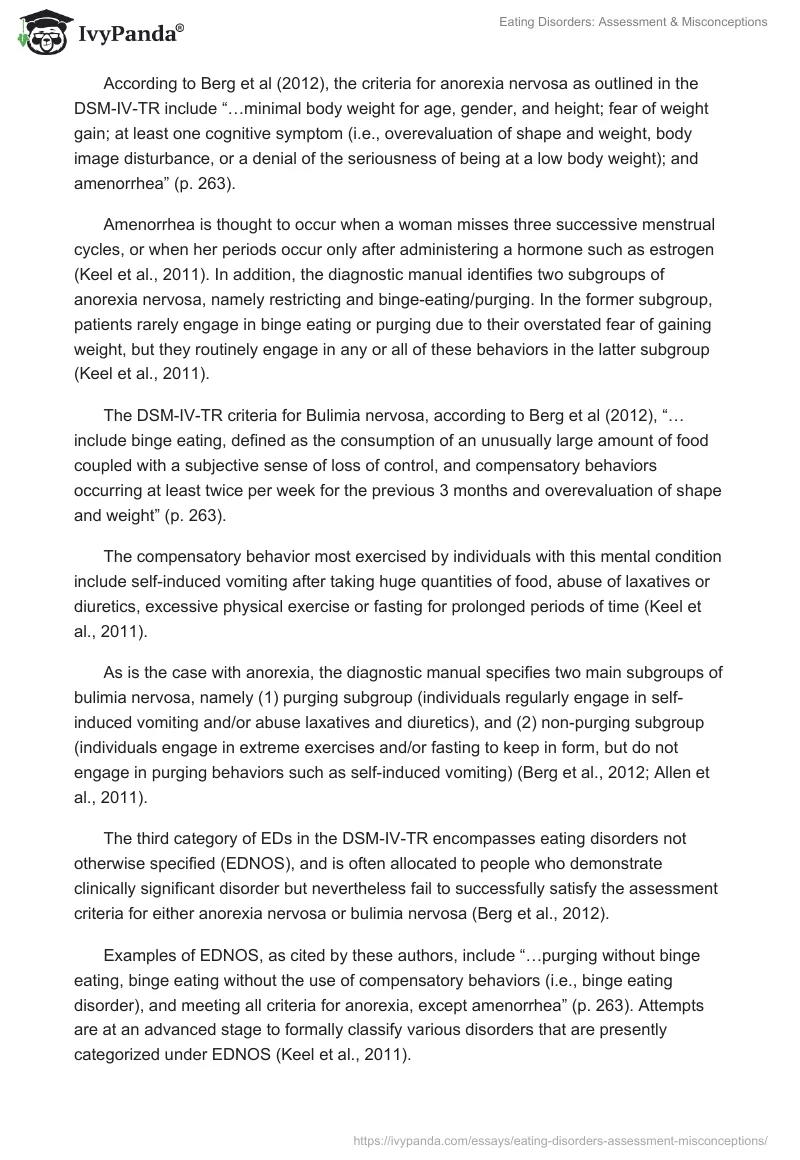Introduction
Eating disorders (EDs), including anorexia nervosa, bulimia nervosa, and eating disorders not otherwise specified (EDNOS), are serious mental illnesses associated with significant psychosocial and physiological morbidity, as well as a broad range of medical and psychiatric problems such as enhanced risk of mortality and poor health.
Indeed, it has been demonstrated through research that anorexia nervosa has the highest mortality rate of any psychiatric disorder, not mentioning that bulimia nervosa and EDNOS are fundamentally associated with health instability (Fursland et al., 2012).
But although extant literature demonstrates the prevalence rate of EDs to be less than 5 percent of the general population (Berg et al., 2012), a serious challenge arises from the fact that many people are reluctant to seek treatment due to lack of information which is critical in making informed decisions (Allen et al., 2011).
The present paper aims to counter this challenge by providing relevant information about EDs, which could then be used by patients not only to assess their status, but also dispel various misconceptions that continue to hinder help-seeking behavior.
Assessing the Eating Disorders according to DSM-IV-TR
As observed by Berg et al (2012), the “Diagnostic and Statistical Manual of Mental Disorders (4th ed., text rev.; DSM-IV-TR; American Psychiatric Association [APA], 2000)” identifies two approved eating disorders, namely anorexia nervosa and bulimia nervosa; however, the diagnostic manual makes mention of binge-eating disorder as a relatively new syndrome though still categorized under bulimia (Bowers & Andersen, 2007), and groups other syndromes under eating disorders not otherwise specified (Fursland et al., 2012).
According to Berg et al (2012), the criteria for anorexia nervosa as outlined in the DSM-IV-TR include “…minimal body weight for age, gender, and height; fear of weight gain; at least one cognitive symptom (i.e., overevaluation of shape and weight, body image disturbance, or a denial of the seriousness of being at a low body weight); and amenorrhea” (p. 263).
Amenorrhea is thought to occur when a woman misses three successive menstrual cycles, or when her periods occur only after administering a hormone such as estrogen (Keel et al., 2011). In addition, the diagnostic manual identifies two subgroups of anorexia nervosa, namely restricting and binge-eating/purging. In the former subgroup, patients rarely engage in binge eating or purging due to their overstated fear of gaining weight, but they routinely engage in any or all of these behaviors in the latter subgroup (Keel et al., 2011).
The DSM-IV-TR criteria for Bulimia nervosa, according to Berg et al (2012), “…include binge eating, defined as the consumption of an unusually large amount of food coupled with a subjective sense of loss of control, and compensatory behaviors occurring at least twice per week for the previous 3 months and overevaluation of shape and weight” (p. 263).
The compensatory behavior most exercised by individuals with this mental condition include self-induced vomiting after taking huge quantities of food, abuse of laxatives or diuretics, excessive physical exercise or fasting for prolonged periods of time (Keel et al., 2011).
As is the case with anorexia, the diagnostic manual specifies two main subgroups of bulimia nervosa, namely (1) purging subgroup (individuals regularly engage in self-induced vomiting and/or abuse laxatives and diuretics), and (2) non-purging subgroup (individuals engage in extreme exercises and/or fasting to keep in form, but do not engage in purging behaviors such as self-induced vomiting) (Berg et al., 2012; Allen et al., 2011).
The third category of EDs in the DSM-IV-TR encompasses eating disorders not otherwise specified (EDNOS), and is often allocated to people who demonstrate clinically significant disorder but nevertheless fail to successfully satisfy the assessment criteria for either anorexia nervosa or bulimia nervosa (Berg et al., 2012).
Examples of EDNOS, as cited by these authors, include “…purging without binge eating, binge eating without the use of compensatory behaviors (i.e., binge eating disorder), and meeting all criteria for anorexia, except amenorrhea” (p. 263). Attempts are at an advanced stage to formally classify various disorders that are presently categorized under EDNOS (Keel et al., 2011).
Indeed, The DSM-V, which is yet to be formally released, has attempted to minimize the prevalence of EDNOS by instituting a broad range of measures, including abolishing the amenorrhea prerequisite for anorexia nervosa as well as embracing binge eating disorder (BED) as a formal eating disorder diagnosis (Berg et al., 2012).
Available literature demonstrates that five in every ten people suffering from anorexia nervosa will transit into bulimia nervosa or EDNOS, and people with bulimia nervosa may also transit into EDNOS over time (Fursland et al., 2012).
However, epidemiological studies as well as validated clinical statistics show that prevalence rates of EDNOS are substantially elevated than those of either anorexia nervosa or bulimia nervosa (Allen et al., 2011), and that “…the associated psychopathology, psychosocial impairment, treatment response, and medical/suicidal risk of EDNOS are comparable with those of anorexia and bulimia” (Berg et al., 2012, p. 263).
Dispelling Misconceptions about Eating Disorders
Extant literature demonstrates that “…although boys and men also experience eating disorders, they are greatly outnumbered by girls and women with eating-related problems” (Schwitzer, 2012, p. 281).
At a global level, according to this author, EDs rank among the ten most common causes of psychological distress in young adult women of diverse racial and ethnic origins. But although this assertion is correct and valid, it should be noted that other research studies have found EDs to affect male populations with the same intensity as experienced in female populations.
Although it has traditionally been assumed that only one in ten cases of eating disorders occur in a male, this perspective has been changed by a recent study of over 10,000 adolescents, ages 13 to 18, which “…found equal numbers of males and females with anorexia” (Fursland, 2012, p. 319). This finding dispels the misconception that EDs are gender-specific, but also demonstrates the likelihood that many male ED cases repeatedly go unnoticed or undiagnosed, making exact approximation of prevalence difficult.
Historically, EDs were thought to be a psychiatric problem limited to Caucasian females from rich family backgrounds (Berg et al., 2012), but recent epidemiological research has discounted this perspective by finding extremely few variations in disordered eating indications among African American, Latina, and European American women in institutions of higher learning (Schwitzer, 2012).
Consequently, the idea that EDs can only affect girls and women of European American descent cannot be supported by research; on the contrary, consecutive studies reveal that EDs are becoming increasingly widespread in broader age ranges, both genders, and diverse ethnic groupings (Berg et al., 2012).
Extant literature demonstrates that “…anorexia tends to develop in adolescence, with peaks in onset at ages 14 and 18, whereas bulimia tends to develop in later adolescence or early adulthood” (Fursland et al., 2012, p. 319).
While this knowledge is objective and valid in as far as EDs are concerned, it has rendered many parents to believe that these disabilities do not affect young children, hence not only making estimates of prevalence difficult but also hindering attempts toward care and management.
Parents need to be acquainted with the knowledge that EDs can also present in young children, some as young as four years, and develop or endure into late adulthood (Fursland et al., 2012; Schwitzer, 2012).
The last misconception relates to risk factors involved in the development of an eating disorder. To date, many people believe that EDs are caused by factors that are innate to the body, such as hormonal imbalances, poor digestive systems and poor food transformation (Berg et al., 2012). However, extant literature demonstrates that gender and social-cultural factors, including the media and Western culture, evidently play the biggest part in the progression of these disorders (Fursland et al., 2012).
As noted by these authors, “…repeated exposure to fashion magazines (which often use technology to modify images) has been found to predict increases in ED symptoms among adolescent girls valuing a thin ideal” (p. 319). Other studies demonstrate that factors such as low self-esteem, early childhood feeding and gastrointestinal problems, stressful life events, and high weight and shape concern, considerably enhance the risk of EDs (Allen et al., 2011; Fursland et al, 2012).
Conclusion
The present paper has not only illuminated assessment criteria for EDs under the DSM-IV-TR, but also taken time to provide useful insights into a number of misconceptions related to the disorders.
It is believed that for effective treatment and management of these disorders, individuals and health professionals need to have sufficient knowledge on how the disorders present as well as their assessment criteria. Additionally, people need to be provided with the correct information regarding the disorders, thus the need to dispel misconceptions that continue to adversely affect help-seeking behavior among the populations most at risk of developing eating disorders.
References
Allen, K.L., Fursland, A., Watson, H., & Byrne, S. (2011). Eating disorder diagnoses in general practice settings: Comparison with structured clinical interview and self-report questionnaires. Journal of Mental Health, 20(3), 270-280.
Berg, K.C., Peterson, C.B., & Frazier, P. (2012). Assessment and diagnosis of eating disorders: A guide for professional counselors. Journal of Counseling & Development, 90(3), 262-269.
Bowers, W.A., & Andersen, A.E. (2007). Cognitive-behavior therapy with eating disorders: The role of medications in treatment. Journal of Cognitive Psychotherapy: An International Quarterly, 21(1), 16-27.
Fursland, A., Byrne, S., Watson, H., La Puma, M., Allen, K., & Byrne, S. (2012). Enhanced cognitive behavior therapy: A single treatment for all eating disorders. Journal of Counseling & Development, 90(3), 319-329.
Keel, P.K., Brown, T.A., Holm-Denoma, J., & Bodell, L.P. (2011). Comparison of DSM-IV versus proposed DSM-5 diagnostic criteria for eating disorders: Reduction of eating disorder not otherwise specified and validity. International Journal of Eating Disorders, 44(6), 553-560.
Schwitzer, A.M. (2012). Diagnosing, conceptualizing, and treating eating disorders not otherwise specified: A comprehensive practice model. Journal of Counseling & Development, 90(3), 281-289.


